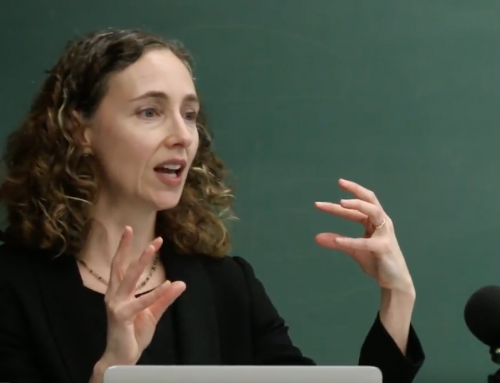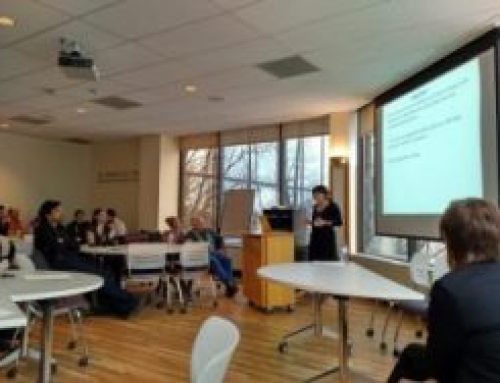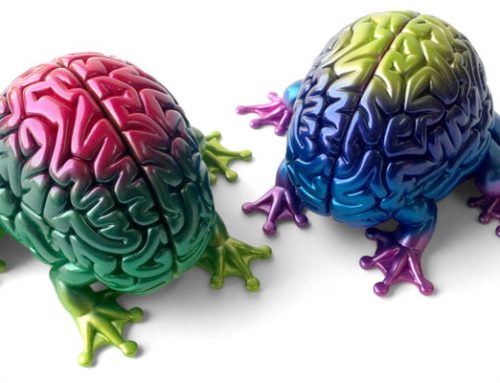By Frédéric-I. Banville
The collaborations between Western’s Brain and Mind Institute (BMI) and the Rotman Institute of Philosophy, in the form of the lab associate program (which places philosophy graduate students in labs at the BMI) and collaborations between researchers (most recently, our postdoctoral fellow Robert Foley co-authored a paper with BMI director Melvyn Goodale and BMI PhD candidate Robert Whitwell), has proved productive. In the interest of furthering the Institute’s expertise in the field of neuroscience, we reached out to Dr. Jennifer Ryan (Canada Research Chair in Cognitive Neuroscience of Memory) from the Rotman Reasearch Institute, Baycrest. On April 23rd, Jen Ryan and members of her lab visited Western for a half-day conference focussing on recent work conducted in her lab. The conference was well-attended by faculty and students from the Philosophy department at Western and the BMI.
Dr. Ryan opened the conference with a talk entitled “Explorations into Memory”, in which she discussed the various ways in which her lab studies interrelated memory systems that give rise to the representations used in on-line cognitive and behavioral performance. Emphasis was put on how the work conducted in the lab adhered to a “converging evidence” approach to cognitive neuroscience, recruiting a variety of techniques to study memory systems. This talk also touched on the dynamical nature of the lab’s approach to these questions, which prompted discussion about important experimental standards in cognitive neuroscience. Notably that of the process-purity of experimental tasks, which is the idea that such tasks should recruit only the cognitive process researchers are interested in (as opposed to a set of processes). With the growing interest in experimental practices that characterizes recent work in philosophy of neuroscience, it is not surprising that the breaks during the conference were filled with lively discussions between philosophers and scientists.
Three postdoctoral fellows from the Ryan lab presented a series of talks that focussed on several of the techniques and questions that Dr. Ryan touched on in her talk. Dr. Kelly Shen’s talk, “Uncovering memory processes in active vision” discussed results showing that active exploration of the visual environment relies not only on attentional processes, but also on visual working memory. These results have important implications for our understanding of active visual exploration, suggesting that the processes involved are more complex than previously thought.
Dr. Rosanna Olsen discussed the use of magnetoencephalography (MEG) in uncovering the role of the hippocampus in binding and comparing memory representations that can then be used by other cognitive systems.
Dr. Maria D’Angelo presented results that suggested that unitization, a process by which disparate elements are “fused” into a single, unified representation, could enable amnesic patients to compensate for certain deficits. Working with amnesic patient DA, who was provided with unitization strategies (in addition to spontaneously using such strategies), they found that amnesic patients could compensate for relational memory deficits by using such strategies.
All in all, this first meeting between these two Rotman Institutes was, by all accounts, very successful. Those involved are hoping that this is just the start of a long and fruitful collaboration between the two Rotman Institutes and the BMI
Referenced papers and further reading:
Foley, Robert T., Robert L. Whitwell, and Melvyn A. Goodale. “The Two-Visual-Systems Hypothesis and the Perspectival Features of Visual Experience.” Consciousness and Cognition, March 24, 2015. doi:10.1016/j.concog.2015.03.005.
Hannula, Deborah E., Robert R. Althoff, David E. Warren, Lily Riggs, Neal J. Cohen, and Jennifer D. Ryan. “Worth a Glance: Using Eye Movements to Investigate the Cognitive Neuroscience of Memory.” Frontiers in Human Neuroscience 4 (2010): 166. doi:10.3389/fnhum.2010.00166.
Olsen, Rosanna K., Renante Rondina, Lily Riggs, Jed A. Meltzer, and Jennifer D. Ryan. “Hippocampal and Neocortical Oscillatory Contributions to Visuospatial Binding and Comparison.” Journal of Experimental Psychology. General 142, no. 4 (November 2013): 1335–45. doi:10.1037/a0034043.
Ryan, Jennifer D., Sandra N. Moses, Morgan Barense, and R. Shayna Rosenbaum. “Intact Learning of New Relations in Amnesia as Achieved through Unitization.” The Journal of Neuroscience: The Official Journal of the Society for Neuroscience 33, no. 23 (June 5, 2013): 9601–13. doi:10.1523/JNEUROSCI.0169-13.2013.
Shen, Kelly, Anthony R. McIntosh, and Jennifer D. Ryan. “A Working Memory Account of Refixations in Visual Search.” Journal of Vision 14, no. 14 (2014): 11. doi:10.1167/14.14.11.
* Thanks to Jessey Wright for help in writing this post.





